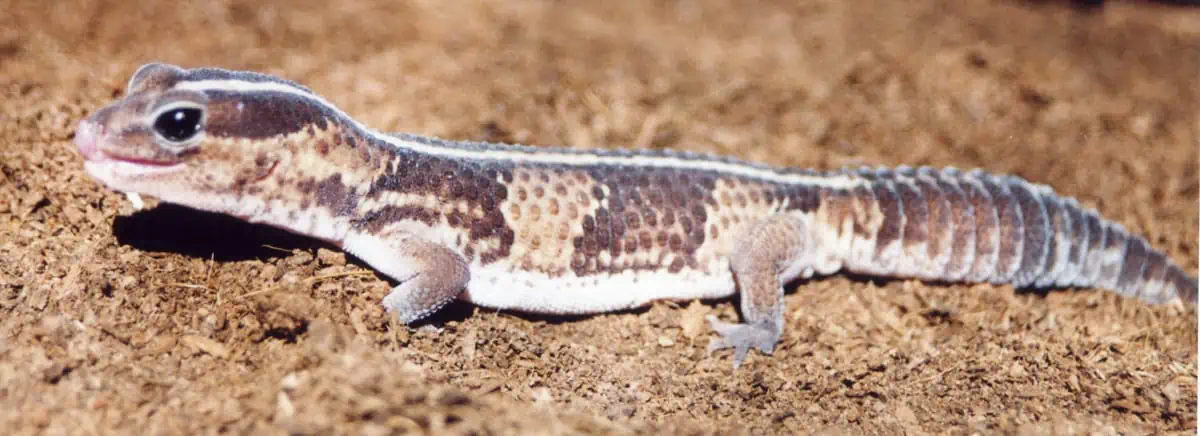African Fat-Tailed Geckos are nocturnal and they spend most of their time hiding in small, humid caves. They’re native to West Africa and they can be found in savannah habitats and rocky hillsides. They look very similar to the Leopard geckos because they are related to them.
These geckos need between 10 and 12 hours of light every day and it’s important that you try your best to mimic their natural habitat while you’re keeping them. They live up to 20 years in captivity so you need to consider that they’re a long-term responsibility.
African Fat Tailed Gecko Lighting Requirements
African Fat-Tailed Geckos are not hard to take care of, especially since they’re very docile creatures. But the biggest advantage is that they have some pretty basic needs. They’re nocturnal so you don’t need to worry too much about the lighting. All you need is a good system that keeps the lights on for as long as it’s scheduled to do, without having any delays or malfunctions.
These geckos need around 12 hours of light during the summer days and around 10 hours during the winter days. This will help the gecko know how to regulate its body and when to sleep. Despite being very docile, they prefer hiding all day and they only come out at night. If you want to observe them being active during the day then this might not be the best gecko choice for you.
When you’re buying the necessary bulbs it’s best to invest in high-quality products as they will last much longer. And if you ever have a power outage, the geckos might get affected if it lasts more than one day. The best way to know for sure that won’t happen is by investing in a system with batteries, a small generator, or a small solar panel for emergencies.
You can usually find exactly what you need online or in exotic pet stores. They’re called reptile light bulbs and they usually come ready to be attached to the ceiling of the cage. Some bulbs are made to be installed inside, but most of them are made to be placed on top of the tank. They also typically come with various safety and backup features.
How many hours of light per day?
African Fat-Tailed Geckos are nocturnal, which means that they thrive the best at night. Their light requirements are very straightforward and you only need to ensure between 10 and 12 hours of light per day. More than that can really mess up with their internal clocks and cause their bodies to react negatively. To ensure a smooth transition, you will have to work a little bit.
The light should stay on for 12 hours during the summer. When fall comes, you’ll need to start minimizing the daylight until it reaches 10 hours a day. And in spring, it’s time to reverse it until it gets up to 12 hours of light every day again. Ambient lighting might be everything you need as the temperature is more important.
But be very careful about how much heat each bulb provides as it can easily overheat the cage if you’re using both a heating mat and light bulb. Since they only come out at night, these geckos don’t need a typical basking spot. All you need to do is provide a heating pad on one side of the enclosure and leave the rest of the tank a bit cooler. The gecko will use this place to regulate its body temperature and it doesn’t need light.
UVB Lighting – What is it
There are various parts in the UV spectrum and everything has its own purpose. Almost every single creature on earth has its days dictated by heat and light. And one of these important lights is the UVB light. It helps produce Vitamin D3, which is something extremely important for geckos.
UVB light always creates a big argument among lizard keepers as some believe nocturnal species have no need for exposure to UVB light. Their argument is that geckos live in their natural habitat without basking in the sun, so offering UVB light is absolutely not necessary.
However, just because they’re living it doesn’t mean they’re thriving and having the best health possible. Since they’re your pets, you need to make sure they benefit from all the help they can get to maintain a healthy life. Vitamin D3 can also be provided through other means besides UVB light, you just need a little bit more experience for that.
There are Vitamin D3 supplements that can be dusted on the insects the gecko is about to eat. But it’s very important to know exactly what you’re doing and use the exact amount that’s recommended. If you feed your gecko too much Vitamin D 3 it can get very sick and develop other health issues. This is why a UVB light bulb that’s around 2% is the best choice at first.
There are many supplements that can offer the gecko what it needs to stay healthy. However, these supplements should only be used if what they need can’t be obtained in a more natural manner.
Do African Fat Tailed Geckos need heat lamps?
The temperature inside the vivarium of an African Fat-Tailed Gecko needs to be monitored closely. It’s recommended to use both a thermostat and a thermometer. The hot side should always be between 90F and 95F, while the cool side is best to remain at 80F.
Cold-blooded creatures need to walk around the tank to regulate their body temperature. To achieve up to 95F on the hot side, you can just install a heating mat right under the hot end of the enclosure. They’re widely available online and in exotic pet stores.
But you should keep in mind that if you have a very cold room the heating mat won’t be able to keep up. You’ll need a combination of various heat sources to ensure that their basking spot remains at 95F.





